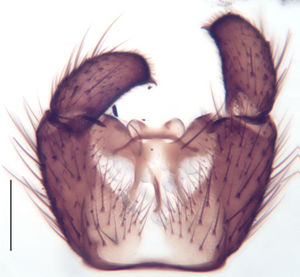Trichosiopsis phoenix infecta
Ordo: Diptera
Familia: Sciaridae
Genus: Trichosiopsis
Species: Trichosiopsis phoenix
Name
Trichosiopsis phoenix infecta unpublished
Type material
Holotype: ♂, 10.07.2015, sweep netting, leg. Remschak, ZFMK-TIS-2592947 in ZFMK
Type locality
Austria, Styria, Gesäuse Nationalpark
Barcoded material
| Stadium | Country | Province | Locality | Habitat | Method | Date | Collector | Collection Number | Collection | Latitude | Longitude | Elevation (m) |
|---|---|---|---|---|---|---|---|---|---|---|---|---|
| 1 ♂ (holotype) | Austria | Styria | Gesäuse Nationalpark, Schröckgraben | sweep netting | 10.07.2015 | Christina Remschak | ZFMK-TIS-2592947 | ZFMK | 47.5315 | 14.6517 | 1160 |
Other material studied
Austria: 1 ♂, Styria, Gesäuse Nationalpark, Johnsbach unterhalb Ebner (Wildgatter, Brunnen), emergence trap, Gerecke, 08.06.2010, PKHH 7744; 1 ♂, Quelle 4 östlich Kalktalbachbett, emergence trap, Gerecke, 29.05.2010, PKHH 7778.
Description (male)
Head. Eye bridge 3–4 rows of facets. Antenna unicolour. LW-index of 4th flagellomere 1.9–2.15; neck 0.15–0.2 × segment width; transition of basal part to neck pronounced. Colour of neck unicolour. Antennal setae shorter than segment width; of normal strength; dense; salient. Palpus darkened; long; palpomeres 3. First palpomere elongate; with 3–4 setae; with only sparse sensilla. Second palpomere elongate. Third palpomere as long as first. Thorax. Colour bright brown, or reddish. Notum unicolour. Thoracic setae normal; brown. Posterior pronotum bare. Mesothoracic sclerites bare. Legs. Colour yellow-brown. Hind coxa of same colour as femora. Setae on front coxa black. Front tibial organ as patch of setae; dark; front tibial organ not bordered. Tibial setae on hind legs weak and inconspicuous. Tibial spurs of equal length. Claws untoothed. Wing. Wing slightly darkened; of normal shape. Wing membrane without macrotrichia. Wing venation weak, with faint stM. M-fork of normal shape. R1 ending at or slightly before base of m-fork; posterior veins with macrotrichia; stM mostly with macrotrichia; CuA1 and CuA2 mostly with macrotrichia; bM bare; r-m mostly setose; bM:r-M 0.8–0.95; st-Cu:bM 0.4–0.6; R1:R 1.5–1.75; c:w 0.68–0.76. Halter darkened; of normal length. Abdomen. Abdominal setae strong; sparse; on tergites black; on sternites black. Hypopygium concolour with abdomen; LW-index 0.6–0.7. Base of gonocoxites with strong setae; gonocoxites broadly separated; inner margin of gonocoxites typically U-shaped; inner membrane of hypopygium scarcely setose; ventral margin of gonocoxite with short setae. Gonostylus elongate; LW-index 1.9–2.15; Inner margin concave; apex equally rounded, or with one obtuse angle. Apical tooth present; without internal structure; of medium strength, or weak; LW-Index 2–3. Awl-like setae normal; beneath apical tooth absent. Megasetae absent. Whiplash-hair absent. Tegmen 0.3–0.5 × longer than broad; rectangular with rounded edges; without special features; central process absent. Length of ejaculatory apodeme/hypopygium 20–28 %. Field with aedeagal teeth inconspicuous. Measurements. Body size 2.8–3.5 mm. Hind tibia 1.3–1.4 mm. Wing length 2.8–3.7 mm.
Diagnosis
The subspecies is differentiated from Trichosiopsis phoenix phoenix apart from the different BIN by brighter legs, a shorter apical tooth at the gonostylus and the complete lacking of subapical awl-like setae beneath the tooth of the gonostylus. Also, the gonostylus appears to be a little bit more curved and tapered apically. The r-m vein is bearing more macrotrichia than the typical form.
DNA Barcoding
The COI sequence is assigned to BIN BOLD:ADG6448 (n=1, K2P: 5.92%).
Etymology
lat. infectus = infected. The name was chosen because of the same stem with the word “defecta”, the species epithet of the similar species Trichosiopsis defecta, which was found in the same region.
Discussion
Trichosiopsis phoenix infecta is known by three specimens from the Austrian Alps, National Park Gesäuse. By the genetic distance it might as well be considered to belonging to a different species. At the time being and without further genetically identified specimens, which might reveal more (or even less) morphological peculiarities, the status of subspecies is considered to be adequate. This finding supports the assumption, that the alpine environment is extremely diverse with respect to Trichosiopsis and that many taxa tend to have very restricted distributions.
Distribution
Austria.
Images
|





